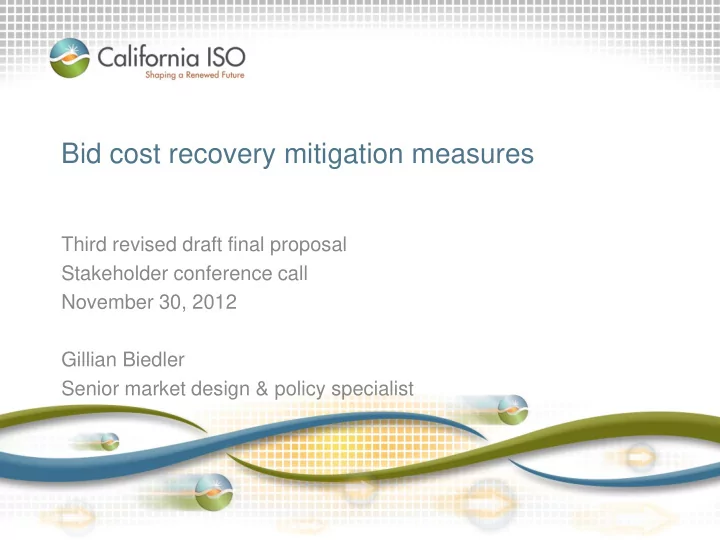

Bid cost recovery mitigation measures Third revised draft final proposal Stakeholder conference call November 30, 2012 Gillian Biedler Senior market design & policy specialist
Overview of changes from the 2 nd revised draft final proposal • Addition of a tolerance band to the application of the modified day-ahead MEAF • Augmentation of the persistent deviation metric to include a tolerance band for small deviations from small dispatches • Change to the rules for changing the bid basis for BCR and the settlement of RIE based on persistent deviation metric flagging of 10-minute intervals Page 2
Application of the tolerance band and ramping tolerance to the modified day-ahead MEAF Page 3
Modified day-ahead metered energy adjustment factor • Modified DA MEAF = min{1, |(Meter – DA ML)/(min{TEE, DA} – DA ML)|} • Where – Meter = metered energy – DA ML = day-ahead minimum load energy – TEE = total expected energy – DA = day-ahead scheduled energy Page 4
Tolerance band and the day-ahead MEAF • Apply tolerance band described in section 6.1 of the proposal to the modified day-ahead MEAF: ~ if ~ |Metered Energy – Regulation Energy – Total Expected Energy| ≤ max{5/6 MWh, 3%Pmax/6 MWh + Ramping Tolerance ~ then ~ Modified day-ahead metered energy adjustment factor is not applied Page 5
Quick review of the proposal on adjustment of bid basis for bid cost recovery and settlement of residual imbalance energy Page 6
Summary of proposal for adjustment of bid cost basis for BCR and settlement of residual imbalance energy • For both the bid basis for energy bid cost recovery and the settlement of residual imbalance energy • The ISO proposes to use a resource’s economic bid – Except in circumstances of exceptional dispatch and minimum load re-rates • Unless … a resource deviates persistently • In which case, the ISO proposes to use – min{DEB, bid, LMP} in the incremental case – max{DEB, bid, LMP} in the decremental case Page 7
Summary of proposal for cost basis for energy bid cost recovery and settlement of residual imbalance energy Bid basis for real-time Settlement of residual Circumstance bid cost recovery imbalance energy Normal Economic bid Reference-hour bid With persistent Min{LMP, DEB, bid} Min{LMP, DEB, bid} deviation (inc case) With persistent Max{LMP, DEB, bid} Max{LMP, DEB, bid} deviation (dec case) To or from an Same settlement basis as Same settlement basis as exceptional dispatch the exceptional dispatch the exceptional dispatch To or from a LMP LMP pmin re-rate Page 8
The persistent deviation metric ~ and ~ Augmentation of the threshold of the persistent deviation metric to include a tolerance for ramping capability Page 9
Persistent deviation metric • The persistent deviation metric = [M(t-1) – M(t)] / [M(t-1) – TEE(t) – Reg(t)] • Where – M(t-1) = metered energy at t-1 – M(t) = metered energy at t – TEE(t) = total expected energy at time t – Reg(t) = regulation energy at time t Page 10
The persistent deviation metric measures the extent to which a resource follows its dispatch from the prior settlement interval If the metric indicates that the resource over-delivers dispatched change in output more than 10% ~ and ~ The deviation is greater than 10% of the resource’s 10-minute ramp capability ~ then ~ The interval is flagged Page 11
Example 1: persistent deviation metric and its threshold • Ramping down above day-ahead schedule (case 2) • Metered Energy (t-1) = 100 • Metered Energy (t) = 75 • Total Expected Energy (t) = 50 • Deviation = 25 MW • Ramp rate = 10 MW/min • PDM = (100-75)/(100-50) = 0.5 • Threshold = (10 MW/min)*(10 min)*(10%) = 10 MW • PDM < 0.9 and deviation > threshold → interval flagged Page 12
Example 2: persistent deviation metric and its threshold • Ramping down above day-ahead schedule (case 2) • Metered Energy (t-1) = 100 • Metered Energy (t) = 97 • Total Expected Energy (t) = 95 • Deviation = 2 MW • Ramp rate = 10 MW/min • PDM = (100-97)/(100-95) = 0.6 • Threshold = (10 MW/min)*(10 min)*(10%) = 10 MW • PDM < 0.9 but deviation < threshold → interval not flagged Page 13
Rules for changing the bid basis for BCR and the settlement of RIE based on the outcome of the persistent deviation metric Page 14
Rules for adjusting the bid basis for BCR and the settlement of RIE based on the number of flagged intervals in the two-hour rolling window: Rules 1-2 Number of Bid basis for real-time Settlement of residual flagged optimal energy BCR imbalance energy intervals calculation 0-3 Economic bid Economic bid for ref-hour 4-12 Min{DEB, LMP, bid} for all Min{DEB, LMP, ref bid} for all intervals intervals Rule 3: Once an interval is flagged, it remains flagged Rule 4: If an interval’s bid base is determined by Rule 1 in a previous evaluation, it can be re-determined by Rule 2 in the next evaluation. Page 15
Deviations will be considered over a two-hour rolling window For hours 2 and 3, For hours 1 and 2, 4 intervals are flagged. 2 intervals are flagged. Rule 2 applies to hour 3. Rule 1 applies to Rule 2 now also applies hours 1 and 2. to hour 2. Hour 1 Hour 2 Hour 3... Interval within the threshold Interval outside the threshold Page 16
Application of the flagging rules and the rolling two-hour window Month 2-hour windows with 2-hour windows with (2012) 0-3 intervals flagged more than 3 intervals flagged June 96% 4% July 94% 6% August 95% 5% September 96% 4% October 96% 4% • Looks only at hours with ramping (4 cases) • Does not account for adjustments due to real-time de-rates • Does not include MSG resources • Uses each resource’s averaged master file ramp -rate Page 17
Contact information Gillian Biedler gbiedler@caiso.com Desk: (916) 608-7203 Mobile: (916) 337-7485 Page 18
Recommend
More recommend